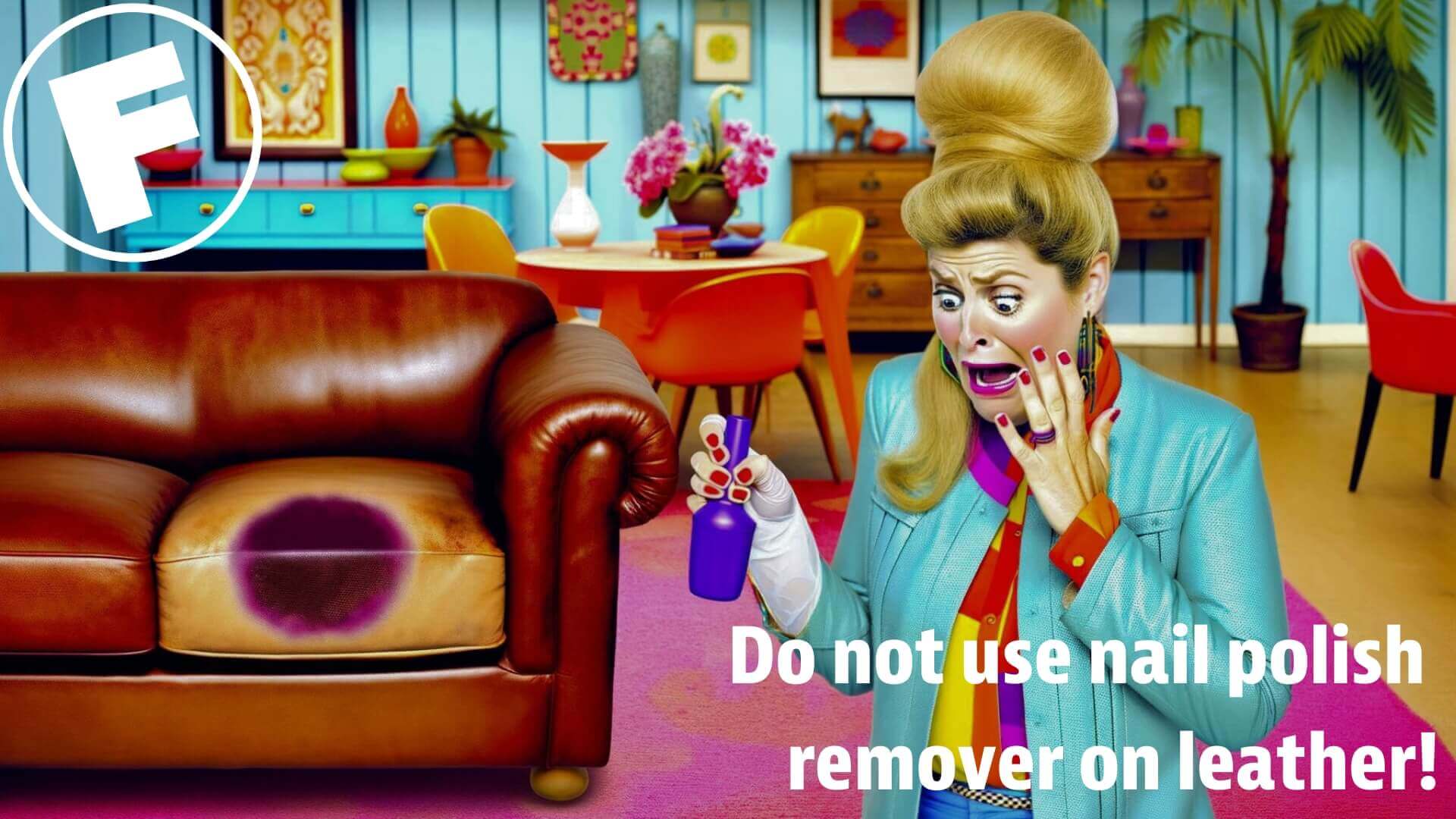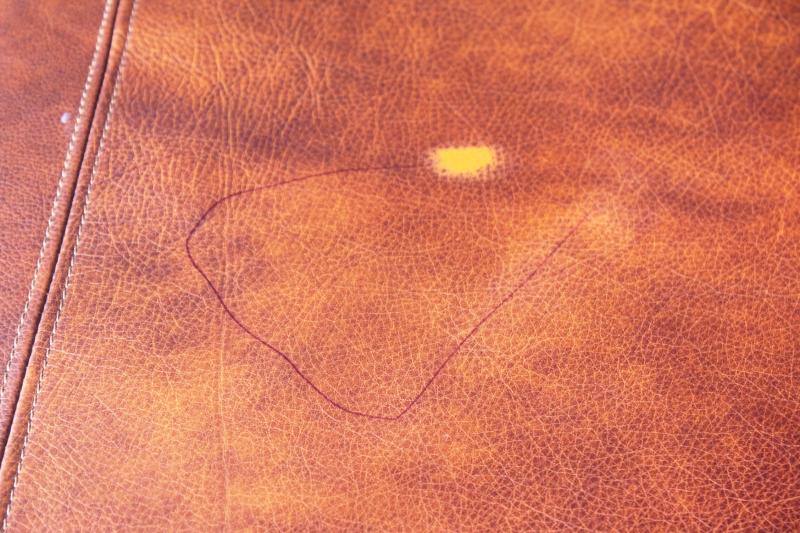Nail Polish Remover on Leather
Nail polish remover will indeed remove marks on leather upholstery, but it also removes the dyes that are supposed to be on the leather, leaving a bleached-out spot on your leather’s surface.
Fingernail polish also wears down the top coat on fully-finished leathers, leaving them more susceptible to damage. Let’s dive deeper into the dangers of nail polish remover on leather.

There are many other home remedies and wives’ tales about using home products on leather We also discourage the use of:
- Olive oil
- Beeswax
- Mink oil
- Hair spray
- Markers
- Window cleaner
- Shoe polish
- Disposable cleaning supplies and wipes
In this article, we’re focussing on nail polish remover and how it harms leather products.
What’s in nail polish remover?
Nail polish remover typically contains a solvent called acetone or ethyl acetate, or a combination of both. These solvents effectively dissolve and remove the polymers and pigments present in nail polish.
Some nail polish removers may also contain additional ingredients such as moisturizers, fragrances, and oils to help mitigate the drying effects of the solvents and to leave nails looking and feeling healthy after use. However, the primary active ingredients in most nail polish removers are acetone or ethyl acetate.
It’s that very primary ingredient that makes nail polish remover a danger to leather sofas, car seats, and more.
The consequences of using nail polish remover on leather
Using nail polish remover on leather furniture—or any leather product for that matter—can pose several dangers due to its harsh chemical composition and the delicate nature of leather:
- Damage to the Leather’s Surface: Nail polish remover contains strong solvents like acetone or ethyl acetate, which can dissolve the protective finish on leather. This can leave the leather vulnerable to damage from moisture, scratches, and other environmental factors.
- Discoloration: The chemicals in nail polish remover can cause the dye in colored leather to fade or transfer, leading to discoloration or staining. Even on untreated leather, nail polish remover can alter the natural color of the leather, resulting in an uneven or splotchy appearance.
- Drying Out: Nail polish remover is highly drying, and prolonged exposure can strip the natural oils from the leather fibers. This can lead to the leather becoming stiff, brittle, and prone to cracking over time.
- Loss of Flexibility: As the natural oils are removed from the leather, it may lose its flexibility and suppleness. This can cause the leather to become rigid and less comfortable to use, especially in the case of leather garments or accessories.
- Chemical Residue: Residue from the nail polish remover may remain on the leather surface even after cleaning, leaving behind an unpleasant odor or potentially harmful chemicals that can irritate the skin upon contact.
- Long-Term Structural Damage: Continuous use of nail polish remover on leather can weaken its structure and lead to irreversible damage, such as cracks, tears, or peeling.
- Health Risks: The fumes emitted by nail polish remover can be harmful if inhaled, especially in poorly ventilated areas. Additionally, direct contact with the skin can cause irritation or allergic reactions in some individuals.

Fingernail polish remover took the color out of this couch when the owner tried to use it to remove the pen mark.
Overall, using nail polish remover on leather is not recommended due to the potential for irreversible damage and adverse effects on both the appearance and structural integrity of the leather.
It’s important to use gentle, leather-specific cleaning products and methods to maintain the beauty and longevity of leather items.
How to clean leather instead
Instead of using nail polish remover on your leather products, you should opt for more gentle and appropriate cleaning methods. Here are some alternative approaches:
- Mild Soap and Water: For general cleaning, use a mild soap diluted in water. Dampen a soft clean cloth with the soapy water and gently wipe the leather surface. Avoid soaking the leather and dry it immediately with a clean, dry cloth.
- Leather-specific Cleaners: Invest in a high-quality leather cleaner specifically designed for the type of leather you have. These cleaners are formulated to effectively remove dirt, stains, and grime without damaging the leather’s finish or color.
- Saddle Soap: Saddle soap is a traditional leather cleaner that can effectively remove dirt and grime while conditioning the leather. Use a damp cloth or sponge to apply the saddle soap in circular motions, then wipe off any excess with a clean, dry cloth.
- Vinegar and Water Solution: A solution of vinegar and water can help remove stubborn stains from leather. Mix equal parts white vinegar and water, dampen a soft cloth with the solution, and gently dab at the stain. Allow the leather to air dry thoroughly.
- Commercial Leather Conditioners: After cleaning, it’s essential to moisturize and condition the leather to prevent it from drying out. Apply a small amount of a high-quality leather conditioner to a soft cloth and gently massage it into the leather in circular motions. Allow the conditioner to penetrate the leather and wipe off any excess.
- Spot Testing: Before using any cleaning or conditioning product on your leather item, perform a spot test in an inconspicuous area to ensure compatibility and to check for any adverse reactions.
- Professional Cleaning: For tough stains or delicate leather items, consider seeking professional cleaning services from a reputable leather cleaner or restoration specialist.
By using these alternative cleaning methods, you can effectively clean and maintain your leather products without risking damage from harsh chemicals like nail polish remover.
Remember to always handle leather with care and follow the manufacturer’s recommendations for cleaning and maintenance.
Trust the Fibrenew pros when it comes to leather care
Using a dedicated, pre-formulated leather cleaner and conditioner/protector will help with cleanliness, durability, water resistance, and every other facet of leather care better than mink oil. Minks may look cheeky and cute—but that doesn’t mean they’ll help your leather.
Fibrenew is always here to give you peace of mind when it comes to all things leather.
Get in touch with your local Fibrenew operator for any questions.
And if you’re passionate about leather, maybe a career in leather repair and restoration is the path for you. Check our free Franchise Information Report for everything you need to know.
Until next time!
Nail polish on leather FAQ
Can I use nail polish to color or repair leather?
It’s not recommended to use nail polish to color or repair leather. Nail polish is not designed for use on leather surfaces and can lead to a range of issues, including damage, discoloration, and deterioration of the leather.
Will nail polish adhere well to leather?
Nail polish may initially adhere to leather, but it is not designed to bond with the surface in the same way as leather dyes or paints. Over time, the nail polish is likely to crack, peel, or flake off, leaving the leather surface looking uneven and damaged.
Can nail polish damage the leather’s surface?
Yes, nail polish can damage the leather’s surface. The chemicals in nail polish can react with the leather, causing discoloration, staining, or deterioration of the finish. Additionally, attempts to remove nail polish from leather can further damage the surface.
Will nail polish change the texture of the leather?
Yes, nail polish can change the texture of the leather. As the nail polish dries and hardens, it can create a stiff or tacky surface texture that is not characteristic of natural leather. This can affect the appearance and feel of the leather item.
Can nail polish cause allergic reactions when in contact with leather?
Nail polish contains a variety of chemicals that can cause allergic reactions or skin irritation in some individuals. When applied to leather items that come into contact with the skin, nail polish may increase the risk of allergic reactions or skin sensitivities.
How can I remove nail polish from leather if I’ve already applied it?
Removing nail polish from leather can be challenging and may require professional assistance. Attempting to remove nail polish using harsh chemicals or abrasive methods can further damage the leather. It’s best to seek guidance from a leather care professional or restoration specialist.
Are there alternative methods for coloring or repairing leather?
Yes, there are alternative methods for coloring or repairing leather that are specifically designed for use on leather surfaces. These include leather dyes, paints, and repair kits that are formulated to bond with the leather and provide long-lasting results without causing damage.
What should I do if I accidentally get nail polish on my leather item?


